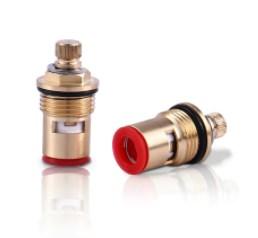The ceramic valve core is an engineered component that is widely utilized in various industries for its exceptional performance characteristics. Known for their precision and reliability, these components are often the heart of fluid control systems, where they manage the flow of liquids and gases with great accuracy. However, the true test of a ceramic valve core's worth lies in its ability to withstand the rigors of high-pressure and high-temperature environments, which are common in many industrial processes.
The durability of a ceramic valve core is a result of the material properties inherent to ceramics. Ceramics are compounds made of inorganic, non-metallic solids, typically oxides, nitrides, or carbides. These materials are renowned for their hardness, wear resistance, and thermal stability, making them ideal for use in valve cores that must operate under demanding conditions.
When it comes to high-pressure applications, ceramic valve cores exhibit remarkable strength. The dense, fine-grained structure of ceramic materials allows them to resist deformation and wear, even when subjected to substantial pressure. This characteristic is particularly important in applications such as hydraulic systems, where the valve core must maintain a tight seal and precise control over the flow of fluid at high pressures.
In addition to their mechanical strength, ceramic valve cores also possess excellent thermal properties. They can operate effectively in high-temperature environments without losing their structural integrity. This is due to the high melting points of ceramic materials, which enable them to maintain their shape and function even when exposed to heat. This resistance to heat makes ceramic valve cores suitable for use in applications such as automotive engines, where components must withstand the heat generated by combustion.
Moreover, the chemical inertness of ceramics means that they do not react with the fluids they control, ensuring that the valve core does not degrade or contaminate the fluid. This is a significant advantage over metal valve cores, which can corrode or erode over time, especially when in contact with aggressive or corrosive fluids.
The design of ceramic valve cores also contributes to their durability. Modern manufacturing techniques allow for the creation of intricate geometries that can withstand the forces exerted by high-pressure fluids. Additionally, the use of advanced ceramics, such as zirconia or alumina, provides enhanced mechanical properties and allows for the creation of valve cores that are both strong and precise.
However, it is important to note that while ceramic valve cores are highly durable, they are not indestructible. Like any engineered component, they have a finite lifespan and can fail if subjected to conditions beyond their design limits. Proper selection, installation, and maintenance are crucial to ensure the longevity and reliability of ceramic valve cores in high-pressure and high-temperature applications.
In conclusion, ceramic valve cores are a testament to the advancements in materials science and engineering. Their ability to endure high pressures and temperatures, coupled with their precision and chemical inertness, makes them a preferred choice in many fluid control applications. As industries continue to push the boundaries of what is possible, ceramic valve cores will undoubtedly play a critical role in enabling the safe and efficient control of fluids in even the most challenging environments.

